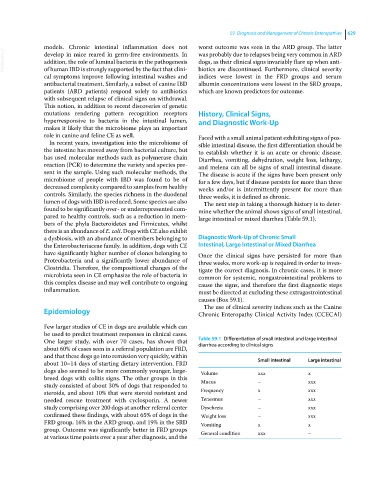Page 661 - Clinical Small Animal Internal Medicine
P. 661
59 Diagnosis and Management of Chronic Enteropathies 629
models. Chronic intestinal inflammation does not worst outcome was seen in the ARD group. The latter
VetBooks.ir develop in mice reared in germ‐free environments. In was probably due to relapses being very common in ARD
dogs, as their clinical signs invariably flare up when anti-
addition, the role of luminal bacteria in the pathogenesis
of human IBD is strongly supported by the fact that clini-
indices were lowest in the FRD groups and serum
cal symptoms improve following intestinal washes and biotics are discontinued. Furthermore, clinical severity
antibacterial treatment. Similarly, a subset of canine IBD albumin concentrations were lowest in the SRD groups,
patients (ARD patients) respond solely to antibiotics which are known predictors for outcome.
with subsequent relapse of clinical signs on withdrawal.
This notion, in addition to recent discoveries of genetic
mutations rendering pattern recognition receptors History, Clinical Signs,
hyperresponsive to bacteria in the intestinal lumen, and Diagnostic Work‐Up
makes it likely that the microbiome plays an important
role in canine and feline CE as well. Faced with a small animal patient exhibiting signs of pos-
In recent years, investigation into the microbiome of sible intestinal disease, the first differentiation should be
the intestine has moved away from bacterial culture, but to establish whether it is an acute or chronic disease.
has used molecular methods such as polymerase chain Diarrhea, vomiting, dehydration, weight loss, lethargy,
reaction (PCR) to determine the variety and species pre- and melena can all be signs of small intestinal disease.
sent in the sample. Using such molecular methods, the The disease is acute if the signs have been present only
microbiome of people with IBD was found to be of for a few days, but if disease persists for more than three
decreased complexity compared to samples from healthy weeks and/or is intermittently present for more than
controls. Similarly, the species richness in the duodenal three weeks, it is defined as chronic.
lumen of dogs with IBD is reduced. Some species are also The next step in taking a thorough history is to deter-
found to be significantly over‐ or underrepresented com- mine whether the animal shows signs of small intestinal,
pared to healthy controls, such as a reduction in mem- large intestinal or mixed diarrhea (Table 59.1).
bers of the phyla Bacteroidetes and Firmicutes, whilst
there is an abundance of E. coli. Dogs with CE also exhibit
a dysbiosis, with an abundance of members belonging to Diagnostic Work‐Up of Chronic Small
the Enterobacteriaceae family. In addition, dogs with CE Intestinal, Large Intestinal or Mixed Diarrhea
have significantly higher number of clones belonging to Once the clinical signs have persisted for more than
Proteobacteria and a significantly lower abundance of three weeks, more work‐up is required in order to inves-
Clostridia. Therefore, the compositional changes of the tigate the correct diagnosis. In chronic cases, it is more
microbiota seen in CE emphasize the role of bacteria in common for systemic, nongastrointestinal problems to
this complex disease and may well contribute to ongoing cause the signs, and therefore the first diagnostic steps
inflammation. must be directed at excluding these extragastrointestinal
causes (Box 59.1).
The use of clinical severity indices such as the Canine
Epidemiology Chronic Enteropathy Clinical Activity Index (CCECAI)
Few larger studies of CE in dogs are available which can
be used to predict treatment responses in clinical cases.
One larger study, with over 70 cases, has shown that Table 59.1 Differentiation of small intestinal and large intestinal
diarrhea according to clinical signs
about 60% of cases seen in a referral population are FRD,
and that these dogs go into remission very quickly, within
about 10–14 days of starting dietary intervention. FRD Small intestinal Large intestinal
dogs also seemed to be more commonly younger, large‐ Volume xxx x
breed dogs with colitis signs. The other groups in this Mucus – xxx
study consisted of about 30% of dogs that responded to
steroids, and about 10% that were steroid resistant and Frequency x xxx
needed rescue treatment with cyclosporin. A newer Tenesmus – xxx
study comprising over 200 dogs at another referral center Dyschezia – xxx
confirmed these findings, with about 65% of dogs in the Weight loss – xxx
FRD group, 16% in the ARD group, and 19% in the SRD Vomiting x x
group. Outcome was significantly better in FRD groups General condition xxx –
at various time points over a year after diagnosis, and the

